One of the most commonly asked questions is, why is my baby waking up crying in the middle of the night? This is something that you may be wondering about yourself. Generally, you will notice that this happens between four and six months. It may make you feel frustrated that they are rolling over and crying. This may happen for many weeks on end. You may be asking yourself if they are getting enough sleep and how you can cope with this baby’s sleeping phase.
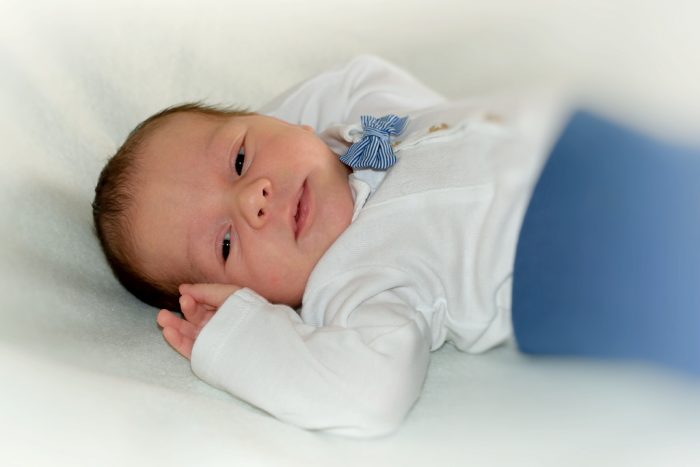
New babies bring with them lots of phases to get through and new things to learn. Tricks for getting the baby to sleep is something all parents work on and continue to work on as their children start learning how to roll over, which leads to sleeping on their stomachs. Pediatricians recommend that newborns and young infants sleep on their backs to help prevent Sudden Infant Death Syndrome. Babies who sleep on their stomach are at an increased risk of Sudden Infant Death Syndrome. Most newborns won’t roll over in their sleep, but at some point, infants learn this new trick. This leads to a lot of anxiety for moms and dads who want their babies to have safe sleep practices. Sleeping face down comes with an increased risk. But, we’re going to help put your mind at ease with this article so you can feel better knowing it’s safe for babies to be sleeping on their stomachs once they’re ready to.
Why Is Your Baby Rolling Over In Their Sleep And Crying?
The only real answer for this is that your baby has now discovered that they can roll over so they decide to do so. Keep in mind that when a baby ages, they are going to practice their skills as they learn them. This is how they get better and grow older. Keep in mind that a child may fall asleep on their stomach. This is common in young children. It may be frightening for you at first. It may make you wonder if it is safe to sleep this way. Is it going to cause sudden infant death syndrome?
You should always place your child on their back as they are infants. This should be practiced until they are a year old according to the facts that were given by the SIDS administration. There have been countless case studies to support safe sleep methods where the babies sleep prone positioned, meaning sleeping face up. A baby sleeping face down can get smothered by the crib mattress if they’re not able to lift their heads very well, or they don’t have that reflex to do so, yet. All those case studies have shown that stomach sleeping can be dangerous.
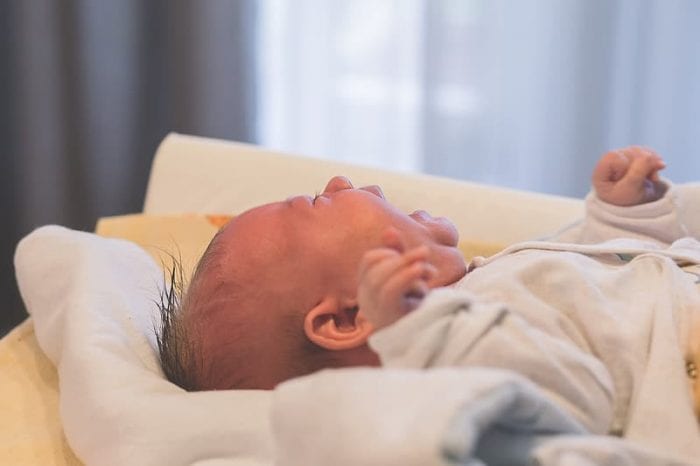
What Is Sleep Regression?
Part of why your baby rolls over during sleep and cries at night may be sleep regression. You may, or may not, know what that means. It’s a period of time when your baby’s sleep patterns are changing. Baby sleep patterns change somewhere around 4 months old. This is also when many infants are learning to roll over. You’ll start noticing that after you put your baby to sleep face up, they don’t sleep long and start waking up a lot fussing and crying.
What’s happening is they’re starting to sleep more like you. Your sleep patterns have you in and out of deep sleep through the night. Newborn baby sleep is usually pretty deep so they don’t wake up easily. Once they hit this sleep regression phase, though, that changes. Now, they’ll start moving in their sleep more, they might hear more noises, and they’re going to wake up and cry. It’s ok and normal, but you’re going to be putting baby to sleep more often through the night. You also need to still be making sure your baby sleeps face up to ensure a safe sleep.
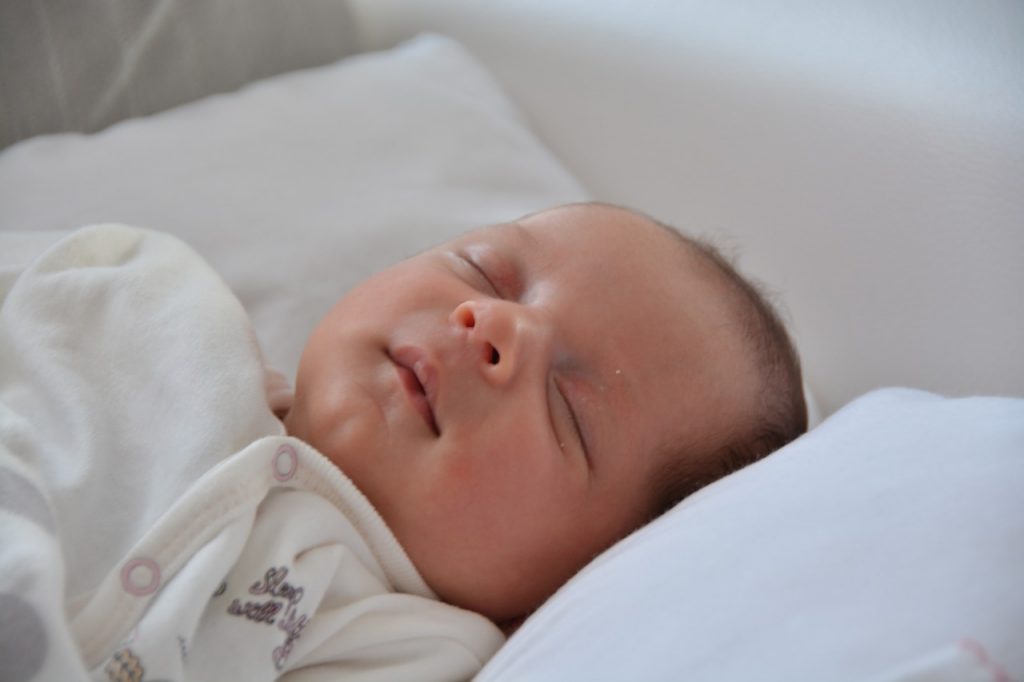
Dealing With Your Rolling Baby
The best way to prevent SIDS is to place your baby on their back for the first year of their life.
- To do this you want to first always put your baby on their back. When putting your baby to sleep, make sure you are avoiding the stomach and side. If you notice that your child is sleeping on his or her stomach, put them back on their back for the first twelve months.
- The next thing that you should do is always do tummy time. This is important so that the baby can learn to roll back. If you practice this, this means less chance of SIDS. It’s safe for a baby to roll over for stomach sleeping if they also know how to roll back.
- Make sure that your child has a safe place to sleep. Their sleeping space should be free of clutter and things. Make sure that there are no blankets or toys in their sleeping area. You want this to be just the baby. An empty crib or even a pack and play works great. The crib mattress should be the only thing in the crib for baby sleep time.
- Call the doctor and talk to them. The baby will cry because he or she is stuck on their tummy at night. However, you can talk to your doctor about more ways to help reduce the risk of SIDS. The doctor can help you with knowing when it’s safe for you to let your little one sleep on their stomach.
Is It Okay For Babies To Roll Over In Their Sleep?
Your child will roll over in their sleep and it can be scary, especially if they start crying. However, you should always be sure to place your child on their back when they are being laid down. If your child rolls over from their back, place them back on their back for the safest results until it’s safe for them to sleep on their stomach.
What Happens When a Baby Rolls From Stomach to Back While Sleeping?
Your child may roll onto their stomach and then to their back. This is normal. This is going to be okay and you should watch your child. Do not intervene for fifteen minutes after the baby has rolled onto their stomach because they may roll back. The only way they’re going to learn to roll back to sleep face up is if you let them try. Plus, it’s important for you to see that they can do it, for your own peace of mind. Sleeping on their stomachs will be safe eventually, you just don’t want them doing it until that time.
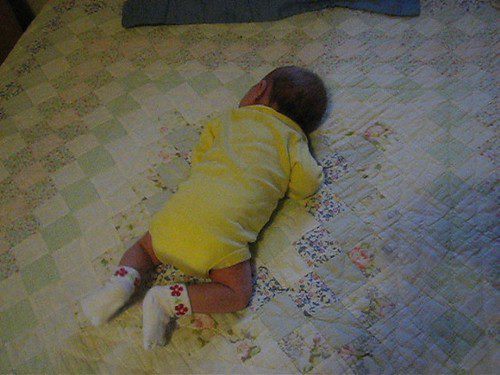
Why Does My Baby Sleep Face Down?
Your baby may be sleeping face down because they have learned to roll to their stomach. Waking babies from naps is necessary in this scenario. You should never allow your child to sleep this way. It can cause SIDS. If you see your child laying this way, you may need to roll them over to their back. There will come a time when sleeping on their stomachs is ok, but you shouldn’t let them do it until it’s safe to do so. Allowing your baby to sleep face down in the crib mattress could turn out to be harmful if it’s too soon.
How Do I Stop My Baby From Rolling Over At Night?
There is not a definitive way to stop this. All you need to make sure that you are doing is making sure that if you see them on their belly to put them back on their back. This is the safest way to reduce SIDS. Any time you put your baby down, lay them down in a prone sleeping position every time you put them in bed. Then, if you see your baby sleeping face down at some point, watch, and if they don’t roll back over then turn them back over to sleep face up.
When Can I Stop Worrying About SIDS?
Generally, this should be taken seriously throughout the first year of the child’s life. However, most cases will happen before the child is four months old. Statistics show, the majority of all SIDS cases will occur before the child is six months old. The reason for this is because your babies neck and core muscles aren’t strong enough when they’re so young to roll themselves back over to a safe sleep position, and they haven’t developed the reflex that tells a sleeping person they can’t breathe. So, if your child is sleeping with their face pushed into the crib mattress and it’s blocking off their oxygen intake, their body doesn’t tell them that and they can smother.
While you should take SIDS prevention seriously, you just need to follow the practices that have been developed over numerous case studies and put your baby to sleep in a prone sleeping position. When a baby sleeps face up, they are at a much lower risk of SIDS.
Should I Worry About My Baby Rolling Over At Night?
You shouldn’t worry too much about your baby rolling over Over in their sleep and crying. However, you shouldn’t let the action go unnoticed. You should make sure that you flip your child back onto their back to prevent smothering by the crib mattress. However, keep in mind that your child may easily roll back onto their back as well. To help your infant develop safe sleep habits, give him or her the chance to try and roll back over to sleep face up again.

What If Baby Rolls From Back To Tummy First?
This happens with babies, every baby is different. All babies should be watched when they are sleeping to ensure that SIDS does not occur. Many parents keep their children in their own rooms next to them for the first few months. That makes it easy to just look over at the bassinet or other safe sleep space to make sure they’re sleeping face up. Once they’re in their crib in their room, you can simply set up a baby monitor so you can keep an eye on them from your room to see that the baby sleeps face up.
If your baby rolls from back to tummy first, make sure that you are practicing tummy time so they can learn to go from their tummy to their back as well.
Why Is It Unsafe For Babies To Sleep On Their Stomach?
It is not safe for babies to sleep on their stomachs because it could cause them to suffocate in the crib mattress.This in turn could result in SIDS. Many case studies have lead to the determination that you need to put baby to sleep in a prone sleeping position. If you don’t allow your baby to sleep face down, you are cutting the risk of SIDS to a minimum.
There are some things we don’t actually know about SIDS, though. However, there are other theories about why a baby sleeping face down is at a higher risk for SIDS. One is that the child ends up in a position where the exhaled air coming from their lungs is blocked from escape and so the baby inhales it back in. This causes a build up of carbon dioxide in the body. When we exhale, we let out carbon dioxide. When we inhale, we are taking in oxygen our bodies need, using it, and then exhaling the waste, or carbon dioxide, that we don’t need. When a baby doesn’t sleep prone, they may not get enough oxygen because they’re inhaling the carbon dioxide they just exhaled.
One other theory for what happens to cause SIDS when a baby sleeps face down on the crib mattress is that their bodies can’t dispel or dissipate heat properly leading to overheating. It hasn’t been completely proven, yet, but it’s certainly something to consider regarding baby sleep habits.

Is It Harder For Babies To Roll From Back To Tummy?
It is harder for most children to roll from their back to their tummy because it requires strong abdominal muscles that are not going to develop as fast as the muscles used to roll from their tummy to their back. It uses fewer muscles to roll from their tummy to their back than it does their back to their tummy.
This is one reason why tummy time is so important for infants. They work hard to develop those core muscles that will allow them to roll back over to sleep face up at night.
How Do I Keep My Baby From Rolling On His Back?
You simply need to watch them and make sure that your baby has adequate tummy time. This will help them be able to roll all the way over so they do not get stuck. Plus, it means that you have less to worry about. Developing safe sleep habits in your baby means both you and your child will be getting better sleep.
Resources for Developing Safe Sleep and Sleep Training
The St. Louis Children’s Hospital has an entire pediatric sleep research center that’s dedicated to baby sleep, sleep regression, a safe sleep campaign, and sleep training for infants. Getting your baby to sleep well is detrimental to their health, and frankly to yours too. You can check out their website to find ideas for sleep training from their helpful sleep campaign information pages. It’s important to remember that child care isn’t just about waking hours, there’s plenty to do when babies are sleeping, also. You want your baby to sleep safely and well so you can have quality time with them when they are awake.
What Is Sleep Training?
Sleep training has many forms. The purpose of it is to help you create better sleep habits for your baby. One of the most recognized forms of sleep training is the cry it out method. However, it’s not the only method, as some people may think. The point is to help get your baby to sleep more easily. You want your child to be able to get themselves to sleep on their own, without too much help from others. This way, if you have other things to tend to or your baby has a child care provider, you and that person can get the things done that need to be.
When you sleep trying, you teach your child how to self soothe. It’s an important skill for all people to have. You’re still going to put your baby to sleep face up in their sleeping space. Then you’re going to choose a method that works best in your home. You may let them just cry until they fall asleep. You could choose to let them cry for a set amount of time before checking back in with them. You can also do the chair method where you put your baby down in the crib to sleep face up and sit in a chair close by. Then each time you put baby to sleep, you move the chair slightly further away, until you just don’t stay in the room at all, eventually.
Again, all you’re trying to do is make bedtime or nap time easier to deal with. When your child can soothe him or herself, they won’t need you to come in the room so much. That means better sleep for your baby and you.
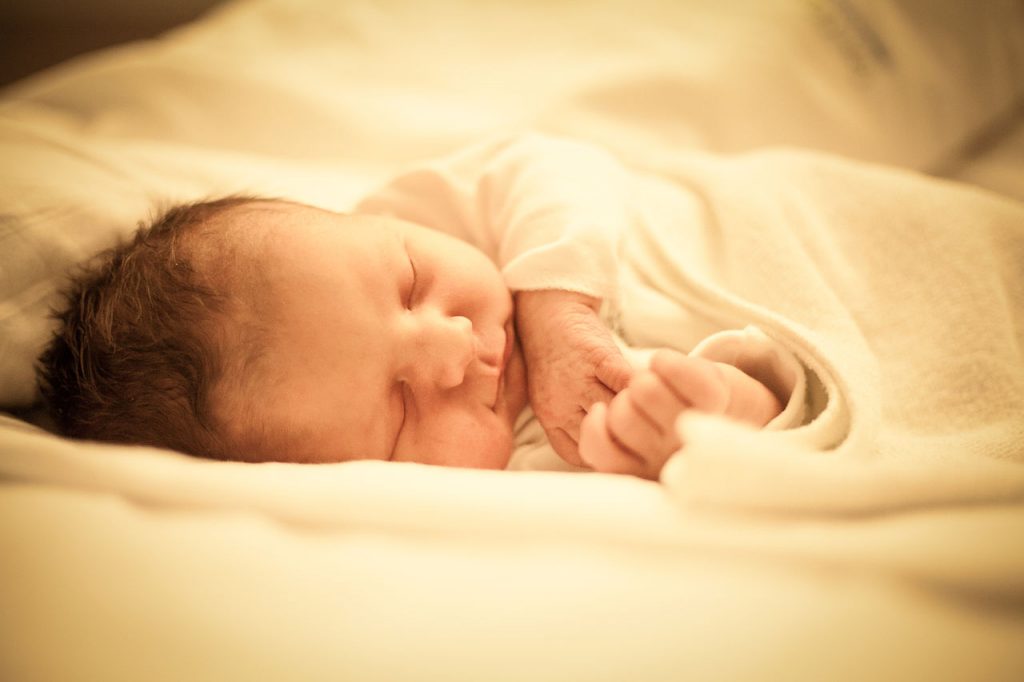
Final Thoughts
As parents, sometimes we just want to find the easiest way to get our baby to sleep. That’s ok, but you still have to be safe about it. When babies start rolling over and crying at night, it can get pretty frustrating. You put your baby to sleep face up and then you find your baby sleeping face down in their crib. You may be tempted to just leave them there because you need to sleep. Sleep can be dangerous, though, when you allow your baby to sleep face down. Even though you don’t want to roll them over because you don’t want to risk hearing them cry, it’s just not worth it to leave them when you discover your baby sleeps face down.
With your help, your baby will learn how to self soothe at night and you both will be sleeping better. It’s likely going to be a short phase. When you put your baby to sleep and then they roll over and start crying, it’s just because they’ve interrupted their own sleep and don’t know how to soothe themselves, yet. Make sure you are rolling your baby back over so baby sleeps face up. Allowing him or her to keep sleeping face down is not a good idea and is very risky. Your sleep, sleep issues with your child, and sleep amounts are all very important. But, your baby sleeping safely is more important, so make sure they’re always sleeping face up during that first year.
Baby Rolling Over In Their Sleep And Crying Other References
https://www.healthline.com/health/baby/baby-rolling-over-in-sleep
https://sleepingwellconsulting.com/baby-rolling-and-waking-heres-what-to-do/
https://www.medicalnewstoday.com/articles/baby-rolling-over-in-sleep
Last Updated on May 11, 2023 by Jeanne Meets
DISCLAIMER (IMPORTANT): This information (including all text, images, audio, or other formats on FamilyHype.com) is not intended to be a substitute for informed professional advice, diagnosis, endorsement or treatment. You should not take any action or avoid taking action without consulting a qualified professional. Always seek the advice of your physician or other qualified health provider with any questions about medical conditions. Do not disregard professional medical advice or delay seeking advice or treatment because of something you have read here a FamilyHype.com.